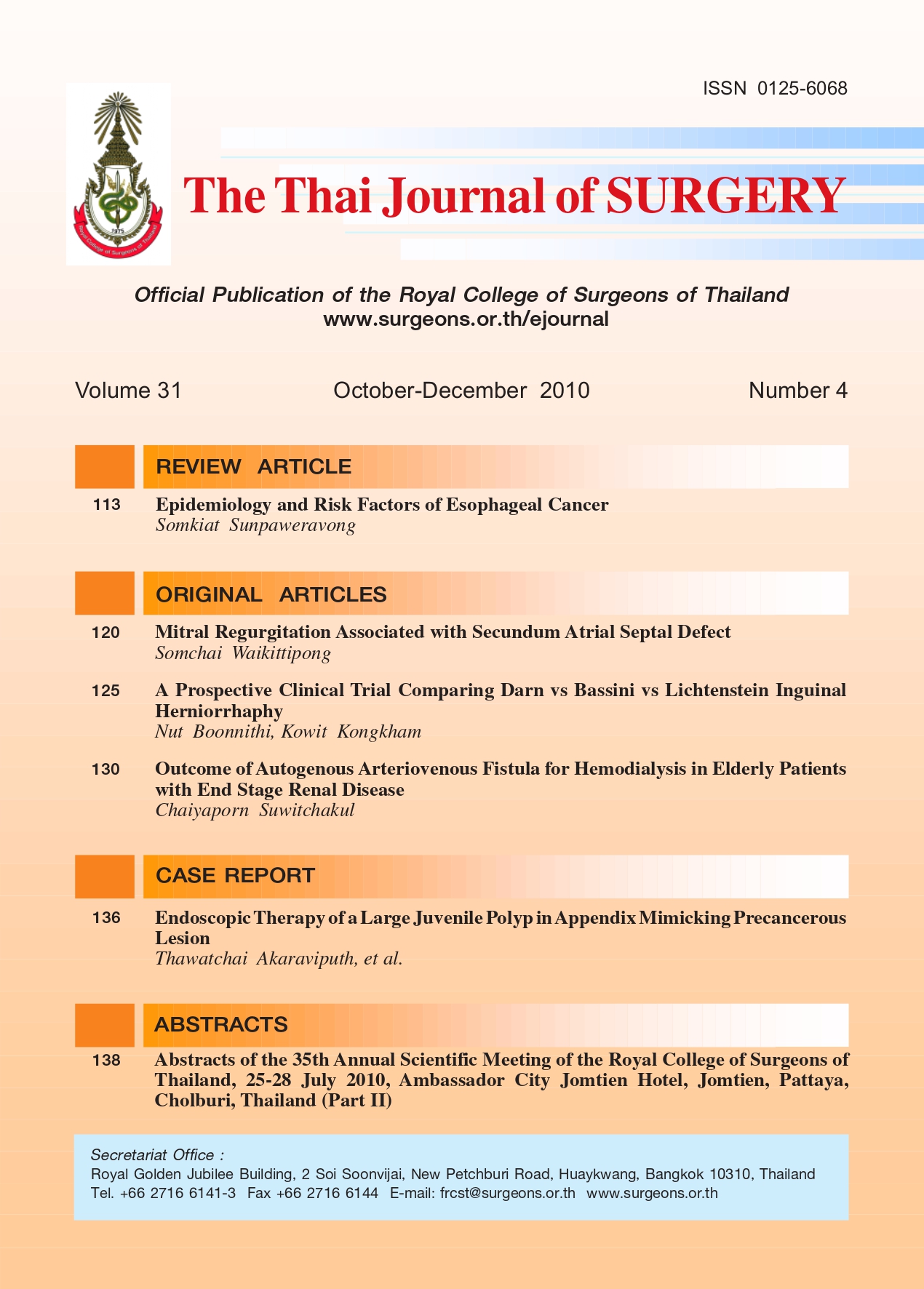A Prospective Clinical Trial Comparing Darn vs Bassini vs Lichtenstein Inguinal Herniorrhaphy
Keywords:
Bassini repair, Darn repair, herniorrhaphy, inguinal hernia, Lichtenstein repairAbstract
Background: Operative procedures for inguinal hernia are one of the most common surgical procedures,but the most effective surgical technique is relatively unknown due to the diversity of surgical techniques and
implanted materials available.
Aim: In this study, we set out to determine whether Darn repair used for inguinal herniorrhaphy is as
effective and safe as other methods.
Patients and Methods: One hundred and ninety seven patients diagnosed with inguinal hernia were
prospectively included between January 1, 2006 - December 31, 2007. They underwent herniorrhaphy with three
different methods as follows: 70 cases with Darn repair, 68 cases with Bassini repair and 59 cases with
Lichtenstein repair. The primary outcome was recurrent rate of hernia at one year and secondary outcome
included operative time, postoperative complication and hospital stay.
Results: No postoperative mortality was found in this study. One patient had a recurrence after Bassini
repair. No recurrent hernia was found in other repair methods. Eight patients had hematoma formation (one
in Darn repair, four in Bassini repair and three in Lichtenstein repair). Two patients had surgical site infection
(one in Darn repair and one in Lichtenstein repair). Mean operative times were 46.1, 35.5 and 42.7 minutes for
Darn, Bassini and Lichtenstein technique respectively. There was a significant difference in operative time
(p = 0.0001) but no significant difference in length of hospital stay or clinical outcome.
Conclusion: Darn technique is a safe, cost effective and relatively easy technique with lower recurrence
rate compared to Bassini technique. However, the recurrence rates between Darn and Lichtenstein techniques
are the same. Postoperative complication did not differ in all techniques.
References
Brunicadi FC, Anderson DK, Billiar TR, Dunn DL, Hunter JG,
editors. Principles of surgery, 9th ed. New York: McGraw-Hill;
2010. p. 1318-22.
2. Malangoni AM, Rosen JM. Hernias. In: Townsend CM,
Beauchamp RD, Evers BK, Mattox KL, editors. Sabiston
Textbook of surgery, The biological basis of modern surgical
practice, 18th ed. Philadelphia: Saunders; 2008. p. 1155-79.
3. Cheah WK, So JB, Lomanto D. Endoscopic extraperitoneal
inguinal hernia repairs : A series of 182 repaireds. Singapore
Med J 2004;45:267-70.
4. Rutkow IM. Surgical operation in the united states. Then
(1983) and now (1994). Arch Surg 1997;132:983-90.
5. Millikan KW, Deziel DJ. The management of hernia:
considerations in cost effectiveness. Surg Clin North Am
1996;76:105-16.
6. Legutko J, Pach R, Solecki R, Matyja A, Kulig J: The history of
treatment of groin hernia. Folia Med Cracov 2008;49:57-74.
7. Kaynak B, Celik F, Guner A, Guler K, Kaya MA, Celik M.
Moloney Darn repaired versus Lichtenstein mesh hernioplasty
for open inguinal hernia repair. Surg Today 2007;37:958-60.
8. Friis E. Tension free herniotomy using the Lichtenstein’s
method. Results of five years experience. Ugeskr-laeger
2000;162:1556-9.
9. Gourgiotis S, Germanos S, Stratopoulos C, Moustafellos P,
Panteli A, Hadjiyannakis E . Lichtenstein tension free repair
of inguinal hernia. Chirurgia (Bucur) 2006; 101: 509-12.
10. Moloney GE. Results of nylon Darn repairs of hernia. Lancet
1958;1:273-8.
11. Abrahamson J. Factors and mechanism leading to
recurrence. Probl Gen Surg 1995;12:151-8.
12. Farooq O, Batool Z, Bashir - ur - Rehman. Prolene Darn : safe
and effective method for primary inguinal hernia. J Coll
Physicians Surg Pak 2005;15:358-61.
13. Manzar TS. Inguinal hernia incidence, complications and
management. JCPSP 1992;2:7-9.
14. Gulzar MR, Haq MI, Iqbal J, Afzal M. Darning VS Bassini repair
for inguinal hernia; a prospective comparative study.
Professional Med J 2007;14:128-33.
15. Quddus-ur-Rehman, Shah TA, Latif U. Inguinal hernia:
Lichtenstein and Darn repair a comparative study.
Professional Med J 2010;17:50-4.
16. Vrijland WW, Van den Tol MP, Luijendijk RW, Hop WC,
Busschbach JJ, de Lange DC, et al. Randomized clinical
trial of non-mesh versus mesh repair of primary inguinal
Hernia. Br J Surg 2002;89:293-7.
17. Zeybek N, Tas H, Peker Y, Yildiz F, Akdaniz A, Tufan T.
Comparison of modified Darn repair and Lichtenstein repair
of primary inguinal hernia. J Surg Res 2008;146:225-9.
18. Chakraborty, Swarup, Mukherjee, Amitava, Bhattacharya,
Maitreyee. Tension free inguinal hernia repair comparing
Darn with mesh : a prospective randomized controlled
clinical trial. Ind J Surg 2007;69:52-6.
19. McGillicuddy JE. Prospective randomized comparision of
the Shouldice and Lichtenstein hernia repair procedure.
Arch Surg 1998;133:974-8.
20. Koukourou A, Lyon W, Rice J, Wattchow DA. Prospective
randomized trial of polypropylene mesh compared with
nylon Darn in inguinal hernia repair. Br J Surg 2001;88:931-4.
21. Barth RJ,Jr, Burchard KW, Tosteson A, Sutton JE,Jr, Colacchio
TA, Henriques HF, et.al. Short Term outcome after mesh or
Shouldice herniorrhaphy: A randomized prospective study.
Surgery 1998;123 :121-6.
Downloads
Published
How to Cite
Issue
Section
License
Articles must be contributed solely to The Thai Journal of Surgery and when published become the property of the Royal College of Surgeons of Thailand. The Royal College of Surgeons of Thailand reserves copyright on all published materials and such materials may not be reproduced in any form without the written permission.



